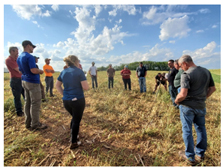
Aaron Augustian knew when he decided to no-till four years ago he was taking a gamble on his farm. Fast forward to today and he isn’t deterred by the naysayers but has the confidence to talk with other farmers about why no-till is increasing his profit margins and saving time.
“You must be confident in what you are doing,” Augustian said in his no-till corn field. “You just put your blinders on and earplugs in and don’t worry about what your neighbors are saying. You need to let the crop show the results. Everyone is chasing bushels per acre and at the end of the day it is more about margin per acre. We are all learning together and are only going to get better at this.”

Augustian was one of nearly two dozen farmers at a Peninsula Pride Farms Conservation Conversation, held on May 25, who discussed the advantages of no-till conservation practices and learning from failures. Peninsula Pride Farms is a farmer-led watershed conservation group in Kewaunee and southern Door counties in northeastern Wisconsin.
Augustian, whose farm is less than 2 miles from Lake Michigan, decided to start no-tilling his land four years ago because of his proximity to the lake. He has noticed there is better water infiltration and when there are heavy rains, he has almost no runoff.
“The soil structure is improving slowly,” Augustian said. “We are noticing that when it rains we have more infiltration of rainwater that stays on the soil. Along with manure application, it seems to stick to the soil better with the growing cover crop out here.”
Augustian started with 25 percent of his acres under no-till practices before advancing to more acres. He is now at 95 percent doing no-till and planting corn into green. He hasn’t no-till planted soybeans yet but is preparing to do so next year.
Nick Guilette from AgSource Laboratories was among several experts who provided insights at the gathering.
“No-till offers some flexibility when it comes to rotation planting,” Guilette said. “When we start talking about soil health benefits, we notice a lot of things: better infiltration, better soil structure, and fewer passes over the field leads to fuel savings. There are several benefits that come quickly when a farm decides to practice no-tilling.”

Increasing bushels per acre isn’t the ultimate goal when implementing a no-till conservation strategy, Guilette said.
“Yield is one thing, but margin per acre is also important,” he said. “There is fuel savings, and Aaron’s field didn’t have to get tilled twice or even three times. There was a no-till pass and maybe a little bit more money was used on the herbicide program. There is some scouting that needs to occur to see if weeds are under control or potentially if there are army or cut worms. It will take a little bit more boots-on-the-ground scouting, but that is a savings per acre.”
Augustian talked about the fall of 2019 when, despite record rains, his no-till fields carried his equipment and had very little ruts.
Guilette emphasized that point.
“What’s the topsoil worth? If you ask 10 different people you will get 10 different answers,” he said. “It’s worth something and it’s worth a lot. I will venture to say I doubt we had any erosion out here. It’s not even a consideration. If we get a 3-inch rain and this was conventionally tilled, I don’t know what would happen.”





